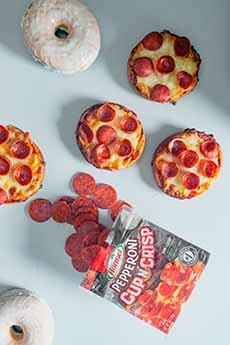The Pepperoni Pizza Doughnut, Topped With Hormel Pepperoni Cup N’ Crisp
|
|
Move over, pizza bagel. You too, English muffin pizza. There’s a new round mini pizza in town: a pepperoni pizza doughnut (photos #1 and #2)! In honor of National Pizza Party Day, May 21st, The Doughnut Project in Greenwich Village, New York City, has teamed up with the makers of Hormel® Pepperoni Cup N’ Crisp. They’ve created a limited-edition pizza doughnut called “Cheese The Day.” And we love it! Known for its trend-forward, hand-crafted doughnuts, The Doughnut Project took inspiration from the little pepperoni cups, that fit easily on a doughnut, crostini, and just about any other place (see photos #3, #4 and #5). There’s more about the pepperoni cups below. Using half of a plain, unglazed doughnut as the base, Cheese The Day is topped with homemade marinara sauce, fresh mozzarella cheese and five yummy pieces of Hormel Pepperoni Cup N’ Crisp. The sweet and savory doughnut is unlike anything The Doughnut Project offered before. It’s a new way to enjoy pizza that you just can’t pass up. The doughnuts will be served warm in-store from Friday, May 21st through Sunday, May 23rd. National Pizza Party Day is celebrated on the third Friday in May. If you’re not in the neighborhood, we encourage you to pick up a bag of Hormel Pepperoni Cup N’ Crisp and make your own. Hormel Pepperoni Cup N’ Crisp is a premium pizza topping uniquely crafted to curl into a bowl shape, cooked to crispy perfection. In the past, all pepperoni used to cup, but production efficiencies eliminated that aspect*. The current pepperoni cup shape—called the roni cup—was re-created by a Columbus, Ohio-based company called Ezzo Sausage Co. A restaurant supplier, Ace Endico, introduced them to the New York market in 2016. The cup style—versus the traditional flat slices—has been gaining in popularity in pizzerias, especially in New York City, where it appeals to the many foodies who are always looking for something new and special. Roni cups became a trend, spawning debates of cups versus flats (i.e., the silver dollar-type slices)—and lots of photos on social media. Hormel, which makes America’s #1 pepperoni brand, caught the trend with HORMEL Pepperoni Cup N’ Crisp. It’s available in two versions: “Peperoni” is the Italian word for bell peppers. There is no Italian salami by that name, and we don’t know how pepperoni was named. Pepperoni itself is an American cured meat salame that was created about a century ago by Italian-American butchers. It has its roots in Italy’s salame piccante. No one can pinpoint when and where, but pepperoni was made by blending finely-ground pork and beef, seasoned with cayenne or chili flakes, garlic, fennel, mustard seeds and/or paprika, and salt, stuffed into a casing and dried. Pepperoni is an example of syncretism: when two or more ideas unite into something new. |
|
|
“Pepperoni” was first mentioned in print in the U.S. Government’s Yearbook of Agriculture in 1894, called “a dry sausage.” It was not until the World War I that the word came into common use for a sausage†, within Italian-American communities. The first known use of the word in print in New York City is in 1919 [source]. Pepperoni is not considered an “Italian” cured meat because it was invented in the U.S. It is “Italian style.” TIP: In addition to topping pizza or mac and cheese, added to a charcuterie board or grilled cheese sandwich, or mixed into pasta dishes, try grinding some pepperoni into meatballs and ragù for an added punch. *Pepperoni was originally made with natural casings that were left on the product as it was sliced. The casing contracted a bit during cooking, causing slices to pucker. After World War II, as manufacturers sought greater production efficiencies, most switched to paper-like fibrous casings, which were typically removed before slicing. These casing-free slices remained flat as they cooked. Producers in a few “holdout” markets, such as Buffalo and Detroit, still made and make the original cupping pepperoni [source]. †Salame (salami is an Americanization of the word) is cured sausage that is fermented and air dried. Sausage, on the other hand, is made using ground meat and it has a casing (skin) around it which protects it from falling apart. CHECK OUT WHAT’S HAPPENING ON OUR HOME PAGE, THENIBBLE.COM. |
||







